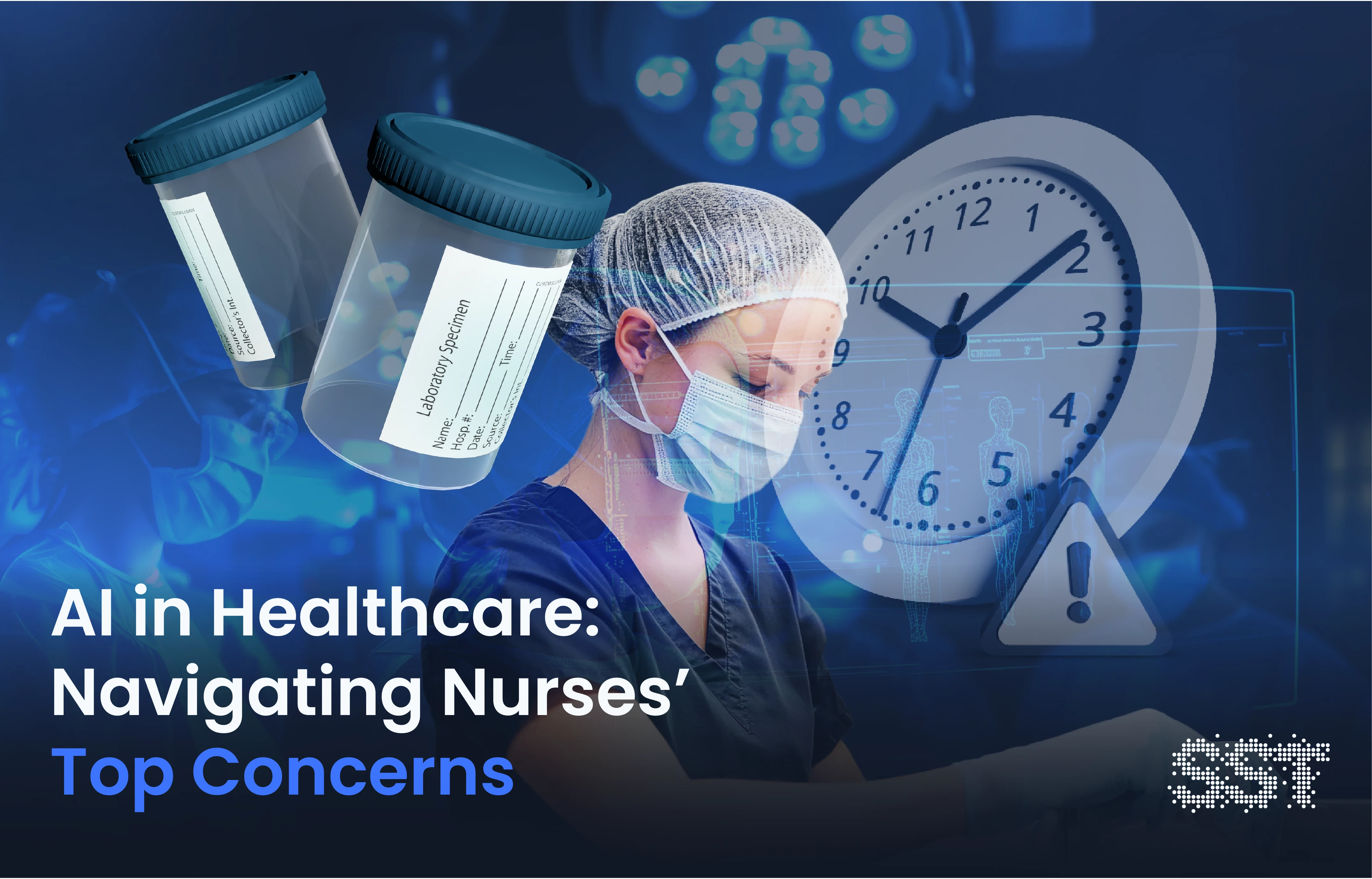ARTIFICIAL INTELLIGENCE
Exploring the Role of Artificial Intelligence in Surgery
Explore how artificial intelligence in surgery is being integrated into preoperative, intraoperative, and postoperative workflows.
Jul 10, 2025
Surgical Safety Technologies
Artificial intelligence is no longer a futuristic concept in the operating room; it is a rapidly growing force. Surgeons use it to plan procedures, guide performance, and evaluate results. From predictive analytics to robotic precision, artificial intelligence in healthcare¹ supports clinical decisions and improves surgical outcomes across specialties.
In this post, we explore the top ways that artificial intelligence is being integrated into preoperative, intraoperative, and postoperative workflows.
Defining Artificial Intelligence in Surgery
Operating rooms worldwide are experiencing a technological renaissance that would have seemed like science fiction just a few years ago. Artificial intelligence in surgery has emerged as one of the most transformative forces, fundamentally reshaping how surgeons plan, perform, and perfect their craft. From robotic systems that translate a surgeon's hand movements into microscopic precision to AI algorithms that can predict surgical complications before they occur, the integration of intelligent technology into surgery represents a paradigm shift toward safer, more effective, and increasingly personalized patient care.
The transformative power of AI in surgery becomes most apparent when examined across the three critical phases of surgical care: pre-operative preparation, intra-operative execution, and post-operative recovery. Each phase presents unique challenges and opportunities where AI is making profound contributions to patient outcomes and surgical excellence.
Using Artificial Intelligence in Surgery for Preoperative Planning
Artificial intelligence delivers tremendous support in revolutionizing surgical planning and risk assessment. Machine learning algorithms analyze vast datasets of medical imaging—CT scans, MRIs, and ultrasounds—to create detailed three-dimensional surgical roadmaps, identify anatomical variations, and predict potential complications before the first incision is made. AI-powered diagnostic tools can detect subtle pathological changes that might escape human observation, while predictive models assess patient-specific surgical risks by analyzing medical histories, lab values, and demographic factors.
The operational efficiency gains from AI-powered systems extend far beyond individual patient care, fundamentally transforming how surgical departments function as integrated ecosystems. These sophisticated OR efficiency tools use real-time visibility and predictive analytics to support comprehensive OR management, creating a dynamic optimization environment that responds to changing conditions throughout each surgical day. By analyzing historical patterns, current patient loads, and resource availability, AI systems can anticipate potential delays before they cascade through the schedule, optimize case sequencing, and proactively flag bottlenecks that could disrupt workflow. This predictive capability enables hospitals to streamline surgical throughput while maintaining quality standards, significantly reducing costly idle time that can average 19%² in traditional OR settings, and ultimately raising satisfaction levels for both clinical staff and patients who experience fewer delays and cancellations.
Advanced surgical video review³ platforms elevate the standard for personalized care through the powered by computer vision and machine learning, allowing surgeons to revisit prior cases with unprecedented analytical depth, automatically identify key procedural moments, highlight anatomical nuances specific to similar patient profiles, and provide quantitative feedback on surgical technique and decision-making patterns. This technology transforms individual surgical experience into collective institutional knowledge, enabling surgeons to study their own cases along with anonymized procedures from colleagues worldwide, thereby accelerating skill development and refining surgical approaches through evidence-based learning rather than trial and error.
Perhaps most critically, AI's ability to synthesize and interpret complex patient data stands to revolutionize the risk stratification process, moving beyond traditional categorical assessments to create nuanced, individualized risk profiles that inform every aspect of surgical decision-making. These sophisticated algorithms integrate diverse data streams—including genetic markers, imaging biomarkers, laboratory trends, medication responses, social determinants of health, and even wearable device data—to generate comprehensive risk assessments⁴ that predict both immediate surgical complications and long-term recovery trajectories and functional outcomes. This holistic understanding enables surgical teams to tailor their approach to each patient's unique risk profile, optimize perioperative protocols, select the most appropriate surgical techniques, and engage in more meaningful informed consent conversations where patients receive personalized risk estimates rather than population-based statistics, ultimately fostering trust and shared decision-making between surgeons and patients.
Using Artificial Intelligence in Surgery for Intraoperative Assistance
The operating room represents the most dynamic and demanding environment in healthcare, where split-second decisions can determine patient outcomes. Here, artificial intelligence emerges as an invaluable surgical partner, providing real-time intelligence that enhances human capability rather than replacing it. Modern robotic surgical systems exemplify this collaboration, utilizing sophisticated AI algorithms to enhance movement precision, reduce tremors, and deliver real-time haptic feedback⁵ that allows surgeons to “feel” tissues through robotic instruments. These systems enable minimally invasive procedures that were previously impossible, resulting in smaller incisions, reduced tissue trauma, and faster recovery⁶ for patients.
The integration of AI-powered computer vision represents a revolutionary leap in surgical awareness and decision-making. These advanced systems analyze live surgical video feeds in real-time, automatically identifying anatomical landmarks, tracking instrument positions,⁷ and providing continuous surgical navigation guidance. In cutting-edge research environments, AI systems are demonstrating semi-autonomous capabilities,⁸ performing precise suturing tasks and managing camera positioning with remarkable accuracy. This technological evolution reduces the cognitive burden on surgical teams, allowing them to focus their expertise on the most complex and critical aspects of each procedure while AI handles routine monitoring and support functions.
Perhaps most significantly, AI's intraoperative capabilities extend beyond individual tasks to create an intelligent surgical ecosystem. AI-driven, clinical intelligence platforms integrate data from multiple sources—surgical instruments, patient monitors, imaging systems, and environmental sensors—to provide surgeons with a comprehensive, real-time understanding of the surgical environment. These systems providing a 360-degree view of the entire clinical experience to help health systems gain unparalleled insights into safety, quality, and efficiency across the entire department, informing quality and safety projects that drive measurable improvements in care delivery and patient outcomes.
Using Artificial Intelligence in Surgery for Postoperative Insights
The power of artificial intelligence to transform surgical outcomes begins with its ability to identify intraoperative outliers and care deviations that signal potential complications—before they become clinically apparent. AI systems can detect subtle deviations such as late antibiotic timing or periods of hypothermia by continuously analyzing patterns in patient data, procedural variables, and environmental factors. This real-time monitoring capability enables surgical teams to anticipate complications such as infection, bleeding, or organ dysfunction before traditional clinical signs would emerge, allowing for proactive interventions that can prevent adverse events or minimize their impact.
Building on this foundation of predictive monitoring, the transformative impact of artificial intelligence extends well beyond the closing of surgical incisions, creating a comprehensive care continuum that enhances patient recovery and drives surgical excellence. Advanced machine learning models establish sophisticated surveillance networks that continuously monitor complex postoperative data streams, including real-time vital signs, laboratory results, medication responses, and clinical documentation. These AI systems excel at pattern recognition⁹ that surpasses human capability, detecting subtle early warning signs of complications such as sepsis, anastomotic leaks, or cardiac events. This predictive capability enables proactive interventions that can prevent minor issues from escalating into life-threatening complications, ultimately reducing hospital readmissions, shortening length of stay, and improving long-term patient outcomes.
One of the most transformative applications emerges in comprehensive surgical case review and outcomes analysis. Traditional case review processes are labor-intensive, subjective, and often incomplete, relying on fragmented data collection and potentially biased recollections. AI revolutionizes this process by automatically synthesizing data from across the entire OR ecosystem—surgical videos, instrument tracking data, patient monitoring information, and post-operative outcomes—to create objective, integrated case analyses. These comprehensive reviews enable surgical teams to identify precise factors that contribute to successful outcomes, understand the root causes of complications, and implement targeted improvements with unprecedented speed and accuracy.
Navigating Limitations and Ethical Considerations in Surgical Artificial Intelligence
Artificial intelligence holds immense promise for reducing surgical errors and improving patient outcomes, though its implementation must be approached with careful consideration of inherent limitations and potential risks. The effectiveness of AI systems fundamentally depends on the quality and representativeness of training data, making them vulnerable to biases¹⁰ present in historical datasets. Surgical AI trained primarily on data from specific demographic groups or institutions may not perform optimally across diverse patient populations, potentially exacerbating healthcare disparities rather than reducing them. Additionally, the complexity of surgical decision-making often involves nuanced factors that may not be captured in quantifiable data, requiring ongoing human oversight and intervention.
The integration of AI into surgical practice also raises important questions about liability, transparency, and the preservation of surgical expertise.¹¹ As AI systems become more sophisticated, maintaining the delicate balance between technological assistance and human judgment becomes crucial. Surgeons must retain the ability to understand, question, and override AI recommendations when clinical judgment dictates, ensuring that technology augments rather than supplants the irreplaceable elements of surgical expertise: experience-based intuition, adaptive problem-solving, and the ability to handle unexpected complications that fall outside algorithmic parameters.
The Future of Artificial Intelligence in Surgery
The trajectory of artificial intelligence in surgery points toward an increasingly integrated, intelligent, and personalized approach to surgical care. Emerging technologies promise to create truly ambient surgical environments where AI seamlessly supports every aspect of patient care without disrupting natural workflows. Future developments¹² will likely include fully integrated OR ecosystems that anticipate surgical needs, provide predictive guidance throughout procedures, and automatically adapt to changing conditions in real-time.
The convergence of AI with other emerging technologies—including augmented reality, 5G connectivity, and advanced robotics—will enable capabilities that seem almost futuristic today. Surgeons may soon operate with AI-powered augmented reality overlays that provide real-time tissue analysis, predictive complication warnings, and step-by-step guidance for complex procedures. Remote surgical assistance, powered by AI and high-speed connectivity, could bring expert surgical guidance to underserved areas worldwide,¹³ democratizing access to specialized surgical care.
As these technologies mature and become more widely adopted, the surgical landscape will transform into a more data-driven, efficient, and safer environment. The hospitals and surgical teams that successfully integrate AI tools while maintaining focus on human expertise and patient-centered care will set new standards for surgical excellence. The future of surgery lies not in replacing human skill with artificial intelligence, but in creating powerful partnerships between human expertise and technological capability that unlock new possibilities for healing and hope.
Interested in how artificial intelligence can support surgical workflows or safety initiatives in your hospital? Let’s connect.
Recommended Reading
Surgical Safety Technologies. (2025, June 17). AI in Healthcare: Navigating Nurses’ Top Concerns [blog post]. https://www.surgicalsafety.com/blog/nursing-concerns-ai-in-healthcare
Tyagi, M., Tyagi, P.K., Singh, S., et., al. (2022). Allocation scheduling leads to optimum utilization of operation theater time. Med J Armed Forces India.;78(Suppl 1), S163-S171. https://www.doi.org/10.1016/j.mjafi.2020.09.005
Villareal, J. (2025, June 17). Surgical Video Review: A Gold Mine for New Residents and Fellows [blog post]. Surgical Safety Technologies. https://www.surgicalsafety.com/blog/surgical-video-review-gold-mine-for-new-residents-fellows
Soliman, C., Walz, J., Corcoran, N.M., et., al. (2025). Risk Prediction Tools for Estimating Surgical Difficulty and Perioperative and Postoperative Outcomes Including Morbidity for Major Urological Surgery: A Concept for the Future of Surgical Planning. Eur Urol Open Sci.;75, 55-60. https://www.doi.org/10.1016/j.euros.2025.03.012
Cho, S., Joo, H., Golla, P., et al. (2024). Tremor Assessment in Robot-Assisted Microlaryngeal Surgery Using Computer Vision-Based Tool Tracking. Otolaryngol Head Neck Surg;171(1):188–196.https://pmc.ncbi.nlm.nih.gov/articles/PMC11211051/
Iftikhar, M., Saqib, M., Zareen, M., et al. (2024). Artificial intelligence: revolutionizing robotic surgery: review. Ann Med Surg (Lond);86(9):5401–5409. https://pmc.ncbi.nlm.nih.gov/articles/PMC11374272/
Villareal, J. (2025, June 17). Kinematics in Surgical Training and Proficiency Assessment [blog post]. Surgical Safety Technologies. https://www.surgicalsafety.com/blog/kinematics-in-surgical-training-proficiency
Knudsen, J.E., Ghaffar, U., Ma, R., & Hung, A.J. (2024). Clinical applications of artificial intelligence in robotic surgery. J Robot Surg.;18(1), 102. https://www.doi.org/10.1007/s11701-024-01867-0
Yelne, S., Chaudhary, M., Dod, K., et., al. (2023). Harnessing the Power of AI: A Comprehensive Review of Its Impact and Challenges in Nursing Science and Healthcare. Cureus;15(11), e49252. https://www.doi.org/10.7759/cureus.49252
Hanna, M.G., Pantanowitz, L., Jackson, B., et., al. (2025). Ethical and Bias Considerations in Artificial Intelligence/Machine Learning. Modern Pathology;38(3), 100686. https://doi.org/10.1016/j.modpat.2024.100686
Surgical Safety Technologies. (2025). AI in Healthcare: Mitigating Legal and Data Security Risks [fact sheet]. https://www.surgicalsafety.com/resources/ai-in-healthcare-mitigating-legal-and-data-security-risks
Morris, M.X., Fiocco, D, Caneva, T, et., al. (2024). Current and future applications of artificial intelligence in surgery: implications for clinical practice and research. Front. Surg.;11. https://doi.org/10.3389/fsurg.2024.1393898
Weiser, T. (2025). Black Box Platform™ Insights [video]. Surgical Safety Technologies. https://www.surgicalsafety.com/resources/black-box-platform-insights-dr-tom-weiser






